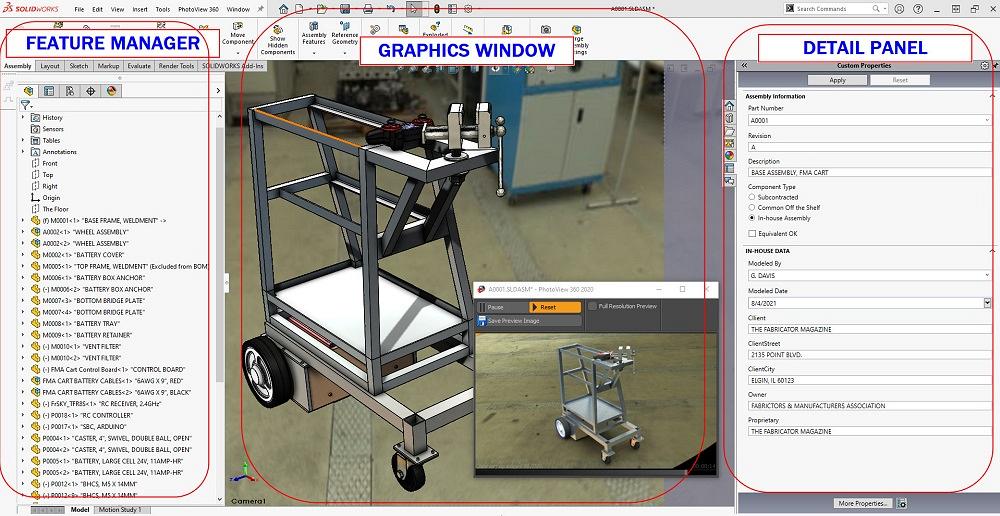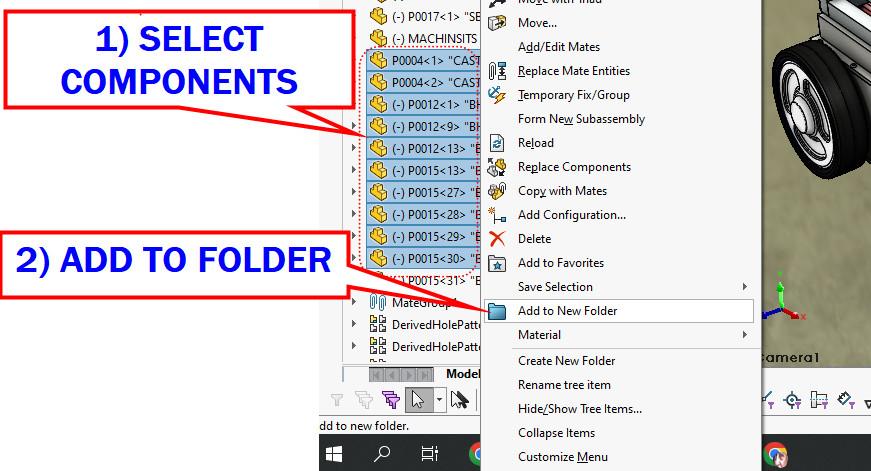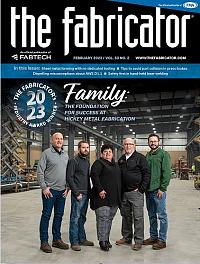Contributing Writer
- FMA
- The Fabricator
- FABTECH
- Canadian Metalworking
Categories
- Additive Manufacturing
- Aluminum Welding
- Arc Welding
- Assembly and Joining
- Automation and Robotics
- Bending and Forming
- Consumables
- Cutting and Weld Prep
- Electric Vehicles
- En Español
- Finishing
- Hydroforming
- Laser Cutting
- Laser Welding
- Machining
- Manufacturing Software
- Materials Handling
- Metals/Materials
- Oxyfuel Cutting
- Plasma Cutting
- Power Tools
- Punching and Other Holemaking
- Roll Forming
- Safety
- Sawing
- Shearing
- Shop Management
- Testing and Measuring
- Tube and Pipe Fabrication
- Tube and Pipe Production
- Waterjet Cutting
Industry Directory
Webcasts
Podcasts
FAB 40
Advertise
Subscribe
Account Login
Search
Tips for preparing a model for review
Organize the model, prepare illustrations, and perhaps export 3D models for a more dynamic experience
- By Gerald Davis
- February 28, 2023
- Article
- Manufacturing Software

FIGURE 1. This rendered image conveys a sense of what it might be like to see the cart on a shop floor.
We are in the midst of using our lovely Custom Properties form to add information to the model preparation of the CAD project for scrutiny by others. As part of this effort, we are using a self-propelled shop cart to carry forward the discussion.
At this stage, the 3D CAD is in its middle stage of development. Many details are emerging. The progress needs to be reviewed and priorities set for the next round of activity.
The audience participating in the model review includes peer CAD personnel, manufacturing, purchasing, quality control, inventors, investors, compliance committees, marketing, and customer support.
Figure 1 is an example of a rendered image created to mimic what the real-world product will look like. Lighting, scenery, and textures all contribute to the realism, or lack thereof, in the image.
The previous episode of this column (and all if its disclaimers about the cart not being real or for sale) discusses the benefits and boundaries of unrealism in presentation.
Figure 2 is a screenshot of a CAD workstation with the cart project underway. This is how a collaborator might see the project. There are three functional sections: the graphics window in the middle, the Feature Manager to the left, and a detail panel to the right. When Figure 2 was created, the workstation was being used to render Figure 1. The preview of the rendering setup is visible in the graphics window.
Because we want to dazzle our peers, the clutter in the list displayed by the Feature Manager needs improvement. It is basically a run-on sentence. Fortunately, the CAD system allows the creation of folders to organize the Feature Manager.
Figure 3 shows a two-step process for setting up a folder with components:
- Select components.
- Right-click to use the Add to New Folder tool.
If a folder already exists, items can be dragged into or out of it. Figure 4 captures the process of dragging the component FMA Car Control Board into the folder named Off the Shelf (OTS) Electronics.
Figure 5 shows a working set of folders in the Feature Manager for this cart project. The folders have been named Drive Frame, Accessory Frame, Off the Shelf (OTS) Electronics, and Off the Shelf (OTS) Hardware. Compared to the Feature Manager shown in Figure 2, this is much tidier.

FIGURE 2. The CAD workstation might be used to review the project. We have designed a lovely Custom Properties form (right), and the 3D model (graphics window in the middle) is beautiful. The Feature Manager is a long list that must be scrolled to review. It is a random list. Functionally for review, it is a run-on sentence.
Perhaps for a wider audience of review, Exploded Views can be used in highlighting components and their relationship to the overall assembly. An Exploded View could show how someone can gain access for service of an item.
Figure 6 lists the four Exploded Views created so far are listed. The Exploded View of the drive assembly has been activated, and the resulting disassembly of one of the drive assemblies is evident.
Here’s a CAD Tip: The Exploded View can be animated. The sequence of steps can be re-ordered after it is created to make a more realistic assembly/disassembly movie.
The use of 3D viewers is a useful means of review. eDrawings (see Figure 7) provides access to component detail, animations, and other views. Its user interface is reasonably intuitive, even for the non-CAD expert. Note that much of the work that went into Figure 1 (textures and colors) can be used by the 3D viewer (eDrawings, Solidworks Viewer).
About the Author
subscribe now

The Fabricator is North America's leading magazine for the metal forming and fabricating industry. The magazine delivers the news, technical articles, and case histories that enable fabricators to do their jobs more efficiently. The Fabricator has served the industry since 1970.
start your free subscription- Stay connected from anywhere

Easily access valuable industry resources now with full access to the digital edition of The Fabricator.

Easily access valuable industry resources now with full access to the digital edition of The Welder.

Easily access valuable industry resources now with full access to the digital edition of The Tube and Pipe Journal.
- Podcasting
- Podcast:
- The Fabricator Podcast
- Published:
- 04/16/2024
- Running Time:
- 63:29
In this episode of The Fabricator Podcast, Caleb Chamberlain, co-founder and CEO of OSH Cut, discusses his company’s...
- Trending Articles
Tips for creating sheet metal tubes with perforations

JM Steel triples capacity for solar energy projects at Pennsylvania facility

Are two heads better than one in fiber laser cutting?

Supporting the metal fabricating industry through FMA

Omco Solar opens second Alabama manufacturing facility

- Industry Events
16th Annual Safety Conference
- April 30 - May 1, 2024
- Elgin,
Pipe and Tube Conference
- May 21 - 22, 2024
- Omaha, NE
World-Class Roll Forming Workshop
- June 5 - 6, 2024
- Louisville, KY
Advanced Laser Application Workshop
- June 25 - 27, 2024
- Novi, MI




























